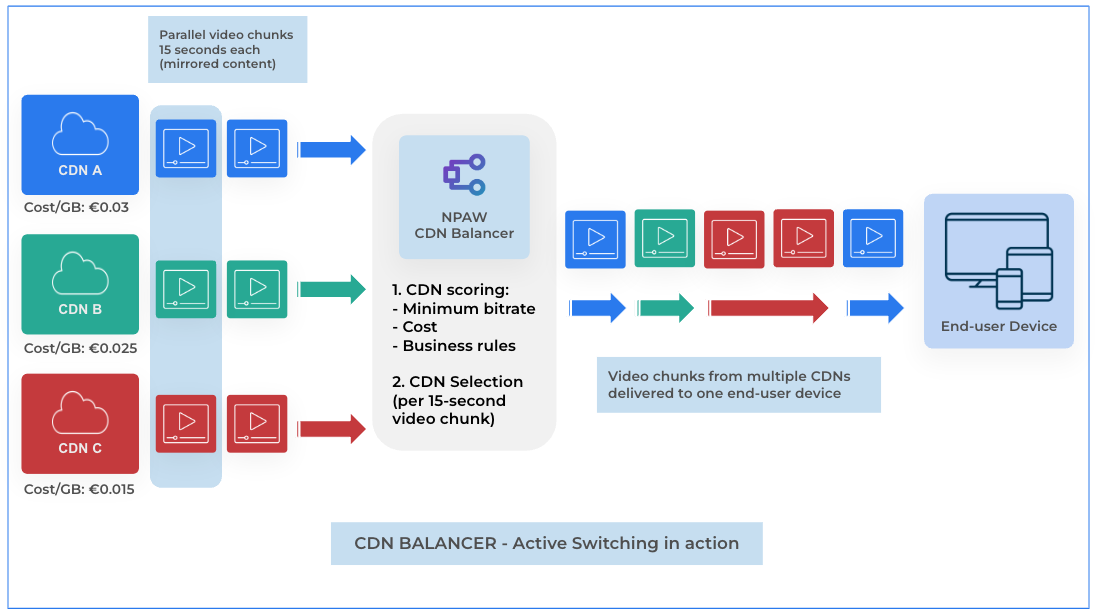Optimizing Video Streaming with Multi-CDN Solutions
In an era where online video streaming has become part of our daily lives, ensuring a seamless viewing experience is critical for both businesses and users. Video streaming platforms must offer fast load times, uninterrupted playback, and consistent quality. A key technology that makes this possible is the Content Delivery Network (CDN). However, with the rise of global video consumption and varying network conditions, relying on a single CDN provider often falls short. This is where a Multi-CDN strategy becomes essential.
What is a Multi-CDN?
A Multi-CDN strategy involves using multiple CDN providers to deliver video content to users. Instead of relying on one CDN to distribute video streams, a Multi-CDN setup dynamically routes video traffic across various CDNs based on real-time performance metrics, user location, and network conditions.
By employing multiple CDNs, video platforms can ensure faster video delivery, increased availability, and improved streaming quality. NPAW’s CDN Balancer is purpose-built to manage multiple CDNs, control usage costs and monitor anomalies affecting the CDN architecture. CDN “Active Switching” is a smart multi-CDN switching feature that automatically selects and switches to the best performing CDN in mid-stream, based on pre-defined business rules.

How CDNs Support Video Streaming
CDNs are critical to the success of video streaming platforms because they store video content in geographically dispersed servers, or edge locations. When a user streams a video, the CDN delivers the content from the server closest to the user, reducing the time it takes to load the video. This minimizes buffering and improves overall video quality by lowering latency.
Network congestion, server outages, and regional restrictions can all affect a single CDN’s ability to deliver content quickly. A Multi-CDN strategy overcomes these limitations by providing access to a broader network of servers across different CDN providers. In essence, a Multi-CDN setup ensures a higher quality of experience and service for your customers.
Why Multi-CDN is Crucial for Video Streaming
- Reduced Latency and Buffering: Multi-CDN systems select the best CDN based on real-time performance data, ensuring that the video is delivered with minimal delay and avoiding the dreaded “buffering” icon. This is especially important for live streaming, where even a few seconds of delay can disrupt the viewing experience.
- Global Content Distribution: Different CDN providers have varying strengths in specific regions. Multi-CDN allows video platforms to optimize delivery by routing traffic through the best-performing CDN in each region, ensuring high-quality streaming for users worldwide.
- Improved Streaming Reliability: Outages and downtime can have severe consequences for video streaming platforms, especially during peak events like live sports broadcasts or major releases. A Multi-CDN setup provides redundancy — if one CDN faces downtime or performance issues, the traffic can automatically failover to another CDN without interrupting the stream.
Cost Efficiency: Although using multiple CDNs may seem more expensive upfront, it can lead to cost savings in the long run. Video platforms can negotiate better pricing by using several providers and route traffic based on cost-effectiveness. By using solutions such as NPAW’s CDN Balancer, streaming providers can dynamically switch between CDN providers, optimizing delivery costs without sacrificing performance.
NPAW CDN Balancer
Key Components of a Multi-CDN Strategy for Video Streaming
Implementing a Multi-CDN strategy involves several critical components to ensure seamless performance:
- Dynamic Traffic Steering: The heart of any Multi-CDN solution is the ability to route video streams to the most appropriate CDN based on real-time data. Traffic steering can be based on factors such as user location, current network conditions, CDN performance, and even specific video requirements.
- Real-Time Monitoring: Monitoring the performance of each CDN in real time is essential for optimizing video delivery. Metrics like load times, video quality (bitrate), latency, and error rates help determine the best CDN to use at any given moment.
- Automated Failover: In the event of an outage or significant performance drop in one CDN, the system should automatically failover to another CDN. This is a core feature of NPAW’s CDN Balancer, which provides both “On-start” CDN selection and “Mid-stream” CDN Active Switching. This ensures that the video stream continues without disruption, providing users with a consistent viewing experience even during technical challenges.
- Geo-Targeting and Custom Rules: With Multi-CDN, video streaming platforms can create custom rules for traffic routing. For instance, viewers in different regions may be directed to specific CDNs based on performance in those areas.
Consistency in Video Quality: Maintain consistent video quality by switching between CDNs based on available bandwidth, server load, and user device capabilities. This adaptive bitrate streaming ensures that users with slower internet connections receive lower-quality streams, while those with faster connections enjoy high-definition (HD) or even 4K streams.

The Multi-CDN Advantage for Video Streamers
A Multi-CDN strategy is essential for video streaming platforms looking to deliver high-quality, reliable, and scalable video content to users worldwide. By leveraging multiple CDNs, platforms can reduce latency, prevent buffering, and ensure uninterrupted streams during peak demand or network outages. Using NPAW’s CDN Balancer to manage and monitor multiple CDNs helps you save on cost while optimizing video quality, making the streaming service virtually bulletproof.
The performance benefits — particularly for global video audiences — make Multi-CDN a crucial technology for video streaming success in the modern internet era. Learn more about NPAW’s video monitoring and delivery tools by visiting our solutions section.

